JHP Newsletter - 2007, No. 4, 13 August
Equipment: Canon EOS 1D Mk III
I received a Canon EOS 1D Mk III recently, and it should be great when it starts working properly! I was hesitant to get a new body because of the price and because it has a different battery than the 1D Mk II and 1Ds Mk II, but after shooting ducks just about all day on an overcast day at ISO 400 and wishing I had more shutter speed, I got on a waiting list for one. My early test shots show at least a one-stop increase in ISO for the same noise as on a 1D Mk II, and I can't wait to be able to take advantage of it.
The 10.1 MP sensor and the ability to shoot 10 fps (frames per second) for up to 30 RAW images are also nice improvements over the 1D Mk II (8.2 MP, 8.5 fps, and a 20 RAW image buffer). The other major change that's appreciated is the My Menu. In addition to the standard menu system, it's possible to create your own menu with frequently-used items. I have it set up with Format, File numbering, Mirror lockup, Sensor cleaning, and Date/Time. While I don't usually use mirror lockup on my "wildlife body," I'm just getting ready for a 1Ds Mk III where I'll be using that function frequently.
Unfortunately, the shutter release isn't behaving properly on my body. It seems that whenever the vertical grip is turned on, there is no intermediate position on the shutter release where IS and AF occurs — the shutter just fires. :(
Equipment: Apple Mac Pro
I also finally got a new Mac to replace my three-year-old PowerMac. Processing images through Capture One and Photoshop was starting to be a real drag, and I'm glad to have a speedy new machine. I bought a Mac Pro with two 3.0 GHz Quad-Core Intel Xeon processors (an 8-core Mac), 1 GB of RAM, and a 250 GB hard drive. I added an additional 8 GB of RAM, a second 250 GB drive in a RAID(0) configuration with the original 250 GB hard drive to create a fast 500 GB boot/application/file drive, and then two 750 GB drives also in a RAID(0) configuration that is partitioned into three volumes: 1) 928 GB of large file storage (the size was selected to be the same as the usable space of an external 1 TB drive that will back it up), 2) 420 GB for a bootable backup of the main drive, and 3) 50 GB for Photoshop scratch space.
The machine really flies!!! I have a Photoshop action that I run on all of my images. For a 16-bit, 16.6 MP image, it took about 26 seconds to run it with Photoshop CS2 on my PowerMac G5 with dual 1.8 GHz processors, and it takes slightly less than 4 seconds to run it with Photoshop CS3 on the Mac Pro!!! Love it!!
While the 8-core 3.0 GHz Mac Pro doesn't run Photoshop any faster than a 4-core 3.0 GHz Mac Pro as long as it's the only program running (www.barefeats.com/octopro1.html), it does let Photoshop keep running at the same speed when additional applications are running (www.barefeats.com/octopro3.html). And, Mac OS X 10.5 should let Photoshop operate faster on the 8-core than the 4-core when it's the only application running. So, with an eye towards immediate and long-term productivity, I bit the bullet and went with the 8-core machine instead of a 4-core machine.
Travel: Colorado Wildflowers
July in Colorado is the height of the wildflower season, and I spent two weeks in the middle of the month in central and western Colorado shooting them. I started near Ohio City and found lots of nice individual shots on Tincup Pass. Elephant Heads (below left) grow in very moist soil and get their name from the individual flower heads which look like an elephant's head.
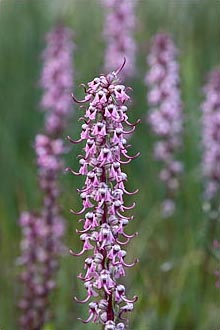
1/10 sec, f11, ISO 100
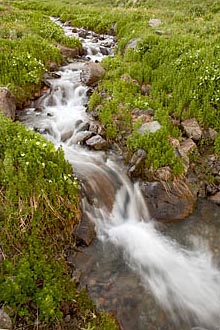
1/4 sec, f16, ISO 100
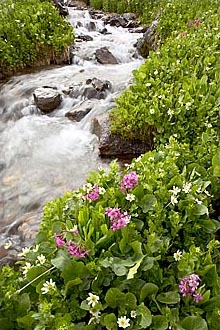
1/8 sec, f11, ISO 100
American Basin, between Lake City and Ouray, one of my favorite locations, was loaded with wildflowers, but the weather wasn't particularly cooperative. There was a slight breeze almost the whole time I was there which made macro shots almost impossible and larger views difficult. The sky was mostly clear, so without any nice clouds to enhance a composition, most of the shots I took didn't include any sky and were made before, or after, direct sun lit the scene. I took a lot of shots of meandering streams (above center) and some streams bounded by wildflowers (above right).
Yankee Boy Basin, northwest of Ouray, is another favorite wildflower location, and I explored all the way to the top of the basin on this trip. It rained every afternoon I was there, and there was just one morning where the breeze abated to allow decent shots to be made. I took mostly shots of individual flowers. The bumble bee on the Western Monkshood (below left) was moving very slowly in the cool morning air, and I used a plamp to help hold the flower still in the light breeze. The Blue Columbine (below center) and Barbey's Larkspur (below right) images just took patience to wait for the breeze to stop and the flowers to stop moving.
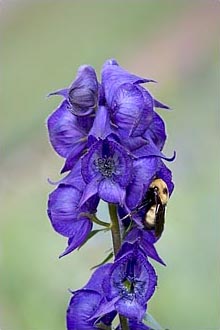
1/10 sec, f11, ISO 100
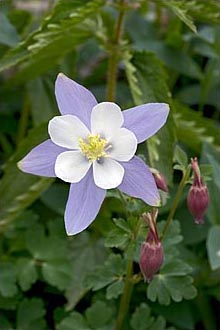
1/45 sec, f16, ISO 100
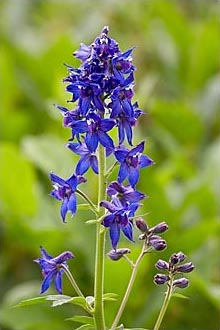
1/60 sec, f8, ISO 100
Then I moved to an area near Mineral Basin, southwest of Ouray. One day, I went up to the top of Black Bear Pass, and on the way back, came across a mother White-Tailed Ptarmigan with three chicks. I had a blast shooting them among the wildflowers (below left). One small gulch between Mineral Basin and Porphyry Basin was loaded with Golden Aster, and the winding stream created a great subject (below center).
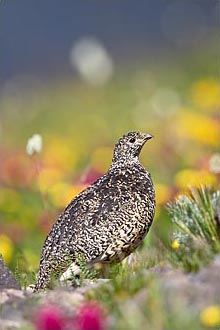
1/1000 sec, f8, ISO 250
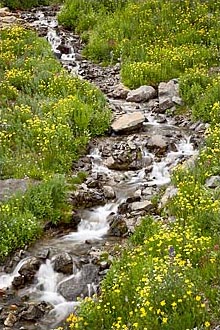
24-105 at 73 mm,
1/2 sec, f16, ISO 100
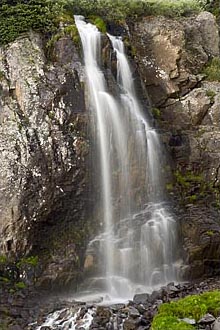
24-105 at 105 mm,
1 sec, f16, ISO 100
I was in search of a waterfall in Porphyry Basin, and found it near the top of the basin after a long, narrow, and sometimes very steep, 4WD road. The image above right was taken late in the afternoon with the falls in complete shade. After the sun set, I was able to capture the whole scene (below left) without any harsh shadows. Early one morning, I hiked up to Bullion King Lake at the head of Porphyry Basin, and was able to get some nice shots as the light first illuminated the headwall (below right).
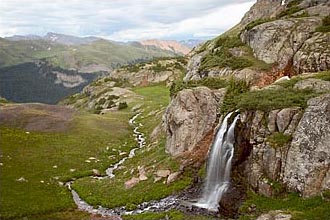
2 sec, f16, ISO 100
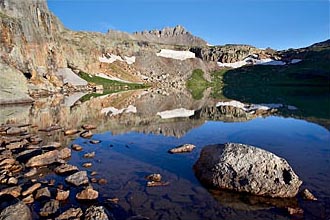
1/30, 1/20, 1/15, 1/10, and 1/8 sec; f16; ISO 100
The final destination was Clear Lake, northwest of Silverton. The lake is in a very nice setting, but I mostly shot subjects other than the lake itself. There is a large scree field near the lake, and I had lots of fun shooting some of the active Picas (below left). Below the lake is a smaller lake (below right) and below that are several nice cascades and small waterfalls.
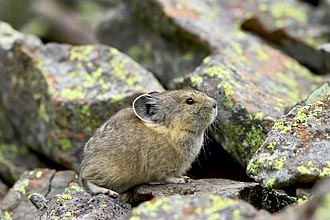
1/90 sec, f8, ISO 400
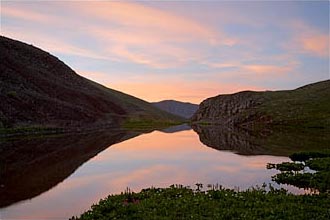
2 and 0.7 sec, f16, ISO 100
Take care, and happy shooting.
— James
James Hager Photography :: www.jameshagerphoto.com




